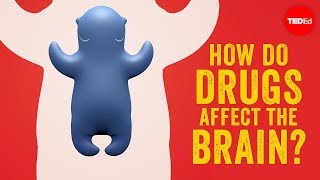(单词翻译:单击)
Most people will take a pill, receive an injection, or otherwise take some kind of medicine during their lives,
大多数人一生中都会吃药丸、接受注射或者以一些其他方式摄入药物,
but most of us don't know anything about how these substances actually work.
但是大多数人并不清楚这些物质到底是如何作用的。
How can various compounds impact the way we physically feel, think, and even behave?
各种化合物如何影响我们身体的感知、思考、甚至行为?
For the most part, this depends on how a drug alters the communication between cells in the brain.
多数情况下,这取决于药物如何改变大脑细胞间的交流。
There are a number of different ways that can happen.
有很多种不同的情况。
But before it gets into the brain,
但在进入大脑前,
any drug must first reach the bloodstream on a journey that can take anywhere from seconds to hours,
任何药物必须首先进入血液,这一过程花费时间从几秒到几小时不等,
depending on factors like how it's administered.
取决于各种因素,诸如进药的方式。
The slowest method is to take a drug orally because it must be absorbed by our digestive system before it takes effect.
最慢的方式是口服药物,因为药物生效前,它必须先被人体的消化系统吸收。
Inhaling a drug gets it into the bloodstream faster.
吸入型药物能较快进入血液。
And injecting a drug intravenously works quickly too because it pumps the chemicals directly into the blood.
通过静脉注射药物的方法也同样会很快作用,因为这种方法把化学药剂直接注入血液中。
Once there, the drug quickly reaches the gates of its destination, the brain.
一旦进入血液,药物会很快抵达目的地,大脑。
The entrance to this organ is guarded by the blood-brain barrier,
而大脑的入口被血脑屏障所保卫,
which separates blood from the nervous system to keep potentially dangerous substances out.
它将血管从神经系统里分离开来,把可能有害的物质阻挡在外。
So all drugs must have a specific chemical composition which gives them the key to unlock this barrier and pass through.
因此,所有的药物必须具备特殊的化学成分,来帮助它们开启血脑屏障并通过。
Once inside, drugs start to interfere with the brain's normal functioning by targeting its web of neurons and synapses.
一旦进入大脑,药物就会作用于神经元网络和突触,开始介入大脑正常机能。
Neurons are brain cells that have a nucleus, dendrites, and an axon.
神经元是具有细胞核、树突和轴突的脑细胞。
Synapses are structures placed along the dendrites or the axon which allow the exchange of electrochemical signals between neurons.
突触是一种沿着树突或轴突分布的构造,允许电化学信号在神经元之间的传递。
Those signals take the form of chemicals called neurotransmitters.
那些以化学物质呈现的信号被称作神经递质。
Each neurotransmitter plays different roles in regulating our behaviors, emotions, and cognition.
每一个神经递质的职责都不同,分别调节我们的行为、情绪和认知。
But they all work in one of two ways.
但它们的运作方式只有两种。
They can either inhibit the receiving neuron, limiting its activity, or excite it,
它们能抑制接受信号的神经元,限制其活动,或者让神经元兴奋,
creating a new electrochemical signal that spreads throughout the network.
产生能传遍整个神经元网络的新的电化学信号。
Any leftover neurotransmitter usually gets degraded or reabsorbed into the transmitting neuron.
而剩下的神经递质会退化,或者被重新吸收,进入传递神经元。
A drug's effectiveness stems from its ability to manipulate these synaptic transmissions at different phases of the process.
药物的效用是基于其在不同阶段对突触传播的掌控能力。
That results in an increase or a decrease in the amount of neurotransmitters being spread.
这会导致被传递的神经递质数量的上升或下降。

For instance, common antidepressants, like SSRIs, stop the reabsorption of serotonin, a neurotransmitter that modulates our moods.
比方说,常见的抗抑郁药物,诸如SSRI,会抑制对五羟色胺的重新吸收,五羟色胺是一种能够控制人们情绪的神经递质。
This effectively pushes more of it into the neural network.
这能有效帮助更多五羟色胺进入神经网络。
Meanwhile, painkillers, like morphine, raise levels of serotonin and noradrenaline,
同时,像吗啡这样的止痛药会提升人体内五羟色胺和去甲肾上腺素的水平,
which regulate energy, arousal, alertness, and pleasure.
能够调节能量、兴奋、机智和愉悦。
Those same neurotransmitters also affect endorphin receptors, reducing pain perception.
这些神经递质也会影响内啡肽接受器,减少对疼痛的感知。
And tranquilizers works by increasing the production of GABA
镇静剂则是通过增加对GABA(γ-氨基丁酸)的生产
to inhibit neural activity putting the person in a relaxed or sedated state.
来抑制神经活动,让人处于放松的、镇静的状态。
What about illegal or elicit drugs?
那么非法药物又是如何作用的呢?
These have powerful impacts on the brain that we're still trying to understand.
这些药物对大脑有着极强的影响,我们仍在尝试解开这一谜题。
Crystal meth, an amphetamine, induces a long-lasting release of dopamine,
冰毒是一种苯丙胺(中枢神经兴奋剂),会导致多巴胺的持续释放,
a neurotransmitter linked with the perception of reward and pleasure.
多巴胺是一种与感知奖励和快乐有关的神经递质。
It also activates noradrenaline receptors, which increases the heart rate, dilates pupils,
它也会激发去甲肾上腺素接受器,导致心率上升、瞳孔扩张,
and triggers the body's fight or flight response.
并触发人体的应激反应。
Cocaine blocks the reuptake of dopamine and serotonin,
可卡因阻碍了多巴胺和五羟色胺的再吸收,
pushing more into the network where they boost energy, create feelings of euphoria, and suppress appetites.
让更多的药物进入神经网络,提升精力,使人产生极度兴奋的情绪,并抑制食欲。
And hallucinogenic drugs have some of the most puzzling effects.
引起幻觉的药物都具有一些让人十分费解的效果。
Substances like LSD, mescaline, and DMT all block the release of serotonin, which regulates mood and impulsivity.
诸如LSD(麦角二乙酰胺)、麦司卡林和DMT(二甲基色胺)这样的物质都会阻碍五羟色胺的释放,而五羟色胺会调节人们的情绪和冲动。
They also have an impact on the neural circuits involved in perception, learning, and behavioral regulation,
这些物质也对感知、学习和行为调节的神经回路产生影响,
which may explain why these drugs have such powerful impacts.
这也许可以解释为什么这些药物有如此强烈的影响。
Even if some of these effects sound exciting, there are reasons why some of these drugs are highly controlled and often illegal.
即使一些影响听起来很刺激,这些药物被严格控制并被视作违法药物是有原因的。
Drugs have the power to alter the brain's chemistry, and repeated use can permanently rewire the neural networks
药物具有改变大脑内化学环境的力量,并且长期使用药物会永久性的影响神经网络的工作,
that support our ability to think, make decisions, learn, and remember things.
这些神经网络能够协助我们进行思考、做出决定、学习和记忆。
There's a lot we still don't know about drugs and their effects, both the good and the bad.
仍有许多我们未知的有关药物及其影响的信息,无论是优点还是弊端。
But those we do know about are the ones we've studied closely, and turned into effective medicines.
但是我们所知的那些是我们进行了细致研究,并制成有效的药物的。
As our knowledge grows about drugs and the brain,
随着我们对药物和大脑相关知识的了解更加深入,
the possibilities will also increase for treating the many medical problems that puzzle researchers today.
治疗许多困扰今天研究者的疾病的可能性也随之提升。


